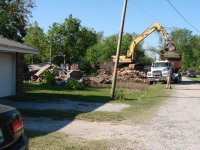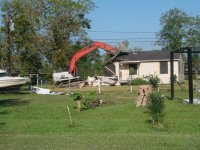BrokenTrack
Veteran Member
- Joined
- Jan 13, 2018
- Messages
- 1,422
- Location
- Maine
- Tractor
- Tractors, Skidders, Bulldozers, Forestry Equipment
I have experience demolishing a few houses...
House 1:
The first was an old house built in the 1960's which was 24 x 40. I used a small excavator (#34,000 pound class) to knock it down which took about 45 minutes. It took another 3 hours to clean up the debris and put it into big steel dumpsters. That took (2 more) than the one we intended to use, and yes I mashed every bit down that I could to get more room. The volume of a house is staggering, so plan ahead. Also, the truck driver would not allow anything outside the metal body, nor anything over the sides of the dumpster. Rental on an excavator that size is about $500 per day, add in $150 for diesel fuel, and then dumpster costs.
House #2
My father had his house burn down and so we took the excavator and hauled it across the road and down to our old gravel pit and let it sit there for a few years not thinking much about it. Then we got tired of seeing it, so we bulldozed it under, but our neighbor called the Dept of Environmental Protection in, and got all cranked up. While we had the legal right to bury the house where it was, by moving it across the road (though we owned the land) it was illegal. Thankfully we know people, and so we sorted it out in fairly short order, and was allowed to bury the rest of the house, but had to permit the area as a "municipal dump", taking it forever out of production as agriculture or as a house lot, and had to do so at the Registry of Deeds in our county. BUT we were fortunate, the gravel pit we have also has sand...the same clay type of sand used to encapsulate old municipal dumps, so we did not have to haul in that special fill. So in this instance, if you can bury the house onsite, do so. Hauling it away may be an issue.
House #3
This was a 1950's trailer and it took exactly 6 minutes with that #34,000 pound excavator to mash it into oblivion and bury it under the earth. Within 3 months no one even knew the thing even existed, much less was there under the soil. That house was however, well out of view and off the beaten path.
House 1:
The first was an old house built in the 1960's which was 24 x 40. I used a small excavator (#34,000 pound class) to knock it down which took about 45 minutes. It took another 3 hours to clean up the debris and put it into big steel dumpsters. That took (2 more) than the one we intended to use, and yes I mashed every bit down that I could to get more room. The volume of a house is staggering, so plan ahead. Also, the truck driver would not allow anything outside the metal body, nor anything over the sides of the dumpster. Rental on an excavator that size is about $500 per day, add in $150 for diesel fuel, and then dumpster costs.
House #2
My father had his house burn down and so we took the excavator and hauled it across the road and down to our old gravel pit and let it sit there for a few years not thinking much about it. Then we got tired of seeing it, so we bulldozed it under, but our neighbor called the Dept of Environmental Protection in, and got all cranked up. While we had the legal right to bury the house where it was, by moving it across the road (though we owned the land) it was illegal. Thankfully we know people, and so we sorted it out in fairly short order, and was allowed to bury the rest of the house, but had to permit the area as a "municipal dump", taking it forever out of production as agriculture or as a house lot, and had to do so at the Registry of Deeds in our county. BUT we were fortunate, the gravel pit we have also has sand...the same clay type of sand used to encapsulate old municipal dumps, so we did not have to haul in that special fill. So in this instance, if you can bury the house onsite, do so. Hauling it away may be an issue.
House #3
This was a 1950's trailer and it took exactly 6 minutes with that #34,000 pound excavator to mash it into oblivion and bury it under the earth. Within 3 months no one even knew the thing even existed, much less was there under the soil. That house was however, well out of view and off the beaten path.


